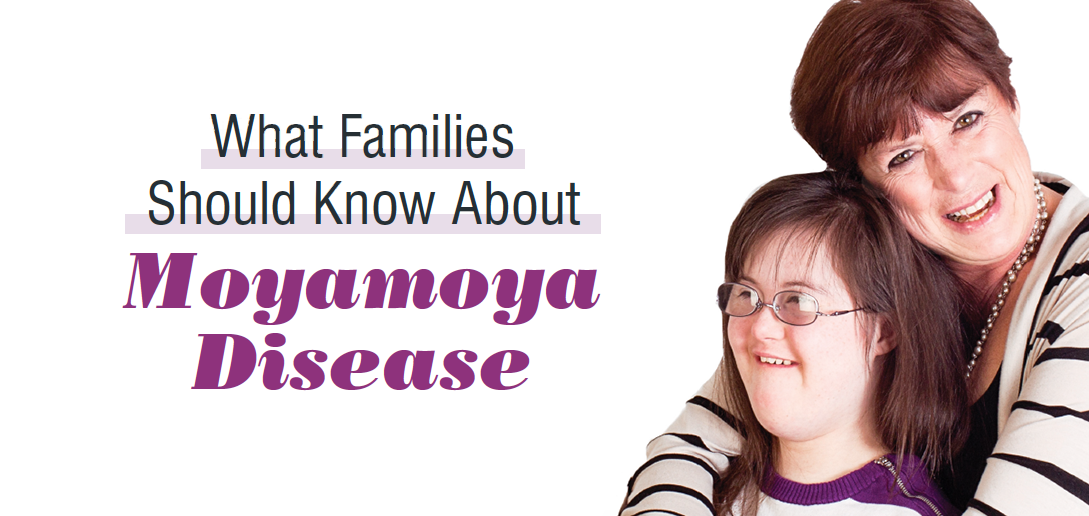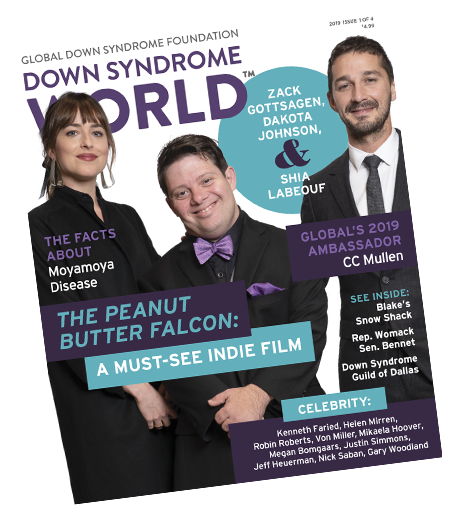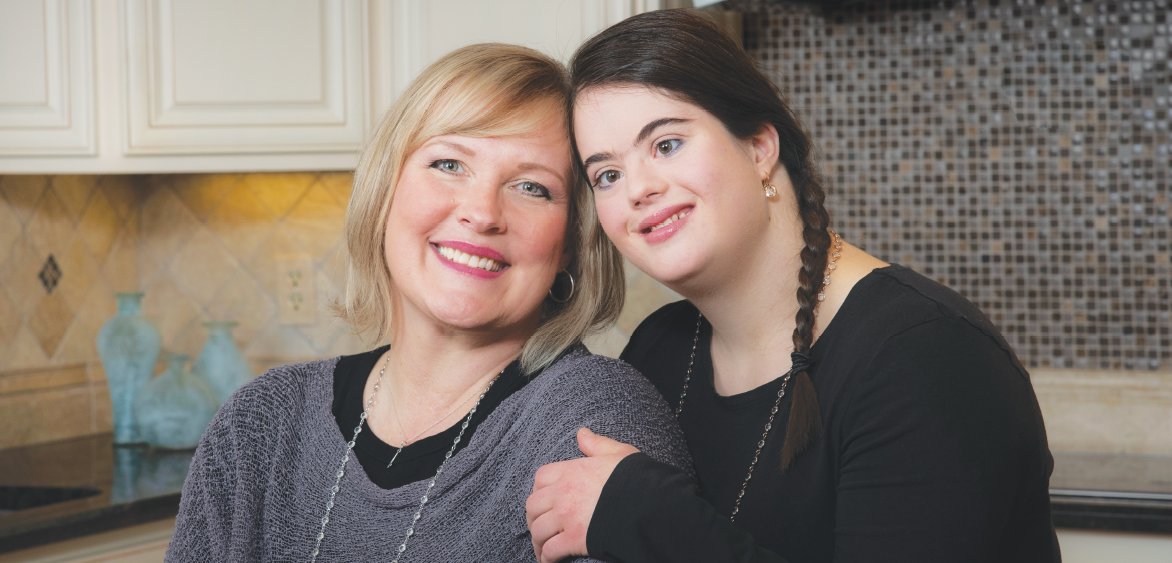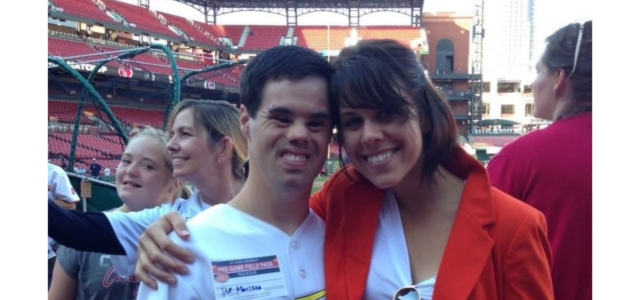
What Families Should Know About Moyamoya Disease

Maria Dellapina and her daughter, Erin Farragher
From Down Syndrome WorldTM Issue 1 2019
This rare disease is significantly more common in children with Down syndrome. Understanding symptoms and early detection could save a life.
“WHAT IS MOYAMOYA DISEASE?” many readers may be asking themselves. It is a rare blood vessel disease caused by blocked arteries in the brain. The name “moyamoya” is derived from a Japanese term meaning “puff of smoke,” because the tangle of vessels often resembles a small puff of smoke. Occurring in approximately 1 out of every 100,000 people, moyamoya disease can be fatal if left undiagnosed and untreated. It is estimated that people with Down syndrome are 26 times more likely to develop the disease, compared with the typical population. It is important for parents of children with Down syndrome to know the warning signs and next steps if their child is diagnosed.
A MOTHER’S STORY
 This article was published in the award-winning Down Syndrome World™ magazine. Become a member to read all the articles and get future issues delivered to your door!
This article was published in the award-winning Down Syndrome World™ magazine. Become a member to read all the articles and get future issues delivered to your door! Maria Dellapina, from Burton, Ohio, is the founder of the award-winning adaptive eyewear company, Specs4Us. Her daughter, Erin Farragher, happens to have Down syndrome. When Erin was 16 years old, she began experiencing unusual symptoms of shaking , fainting, and muscle aches.
“Erin called out to me, I turned around, and she was shaking all over and fell to the ground,” recalls Dellapina. Initially, Dellapina thought her daughter had experienced a mini-stroke, but Erin bounced back quickly.
However, Erin’s symptoms continued to occur — more headaches, more muscle aches, and poor balance. In Dellapina’s search for answers, she received an email from a parent, who, based on his experience with his daughter, advised Dellapina to look into moyamoya disease, a term with which she was unfamiliar.
Growing increasingly concerned with Erin’s “off” behavior over the next few days, Dellapina decided to take Erin to the emergency department at a local hospital.
“When I pulled into the parking lot, Erin star ted throwing up,” Dellapina recalls. “The physicians thought Erin had the flu. They even laughed when I mentioned moyamoya.”
Not convinced, Dellapina took Erin to another hospital in Cleveland. A CT scan revealed Erin had suffered from a stroke. In fact, it was just one of several strokes and transient ischemic attacks (TIAs), also called “mini-strokes,” that Erin had apparently experienced throughout her young life. Later, at Cleveland Clinic, an MRI and angiogram led physicians to diagnose Erin with moyamoya disease.
LEARNING ABOUT MOYAMOYA
Anytime families receive an unexpected diagnosis, it can be very overwhelming and scary. Knowing the facts and what to expect can help ease some of that fear. Moyamoya disease occurs when the internal carotid arteries at the front of the neck that supply the brain with oxygenated blood gradually narrow, says Raphael Sacho, M.D., F.R.C.S., Assistant Professor of Neurosurgery at the Medical College of Wisconsin. As those vessels narrow, the two vertebral arteries at the back of the neck compensate by developing small blood vessels called collaterals. This causes a tangling of blood vessels in the brain, restricting blood flow.
“Collaterals take over the function of the internal carotid arteries over time,” Dr. Sacho explains. “That, in itself, can cause problems because the collaterals can be small, thin, and not used to taking so much blood. They can burst and cause bleeding.”
As a result, many people with moyamoya disease experience strokes, just as Erin did. All types of strokes share symptoms such as headaches, seizures, visual disturbances, one-sided weakness, slurred speech, involuntary movements, and cognitive impairment. Some common strokes that occur with people who have moyamoya disease are TIAs, ischemic strokes, and hemorrhagic strokes. TIAs occur when blood flow to the brain is interrupted briefly but then resumes, which is why they are often called “mini-strokes.” Ischemic strokes occur as a result of a blood clot completely blocking an artery that supplies the brain with blood. Hemorrhagic strokes — major brain bleeds — may occur if blood vessels or collaterals burst.
The reason people with or without Down syndrome develop moyamoya disease is unclear.
It’s thought that genetics may play a role, as several mutations to the gene RNF213 are associated with moyamoya disease. Infection or inflammation may also be involved in its development, according to the National Institutes of Health (NIH).

Mary Beth Freckmann and her daughter, Madie Ehlers
PREVALENCE AND THE IMPORTANCE OF EARLY DETECTION
“In the United States, it was thought moyamoya disease occurred in 0.1 per 100,000 people,” says Gary Steinberg, M.D., Ph.D., Chair of Neurosurgery, Director of the Stanford Moyamoya Center, and Founder and Co-Director of the Stanford Stroke Center. “More recent studies have shown the incidence may be 0.5 or closer to 1 per 100,000 because it’s been under-recognized in the U.S.”
While the disease is rare in the general population, people with Down syndrome are 26 times more likely to develop the disease than typical people, according to Dr. Sacho. The reasons for that discrepancy are also unclear, though signs seem to point to genetics. He adds that, in Down syndrome, there’s something about the triplication of chromosome 21 (the defining characteristic of Down syndrome) that predisposes this population to moyamoya disease.
The disease can be more difficult to detect in children with Down syndrome than typical children, which may explain why, on average, children with Down syndrome are diagnosed with moyamoya disease nearly two years later than typical children. According to a 2015 study by researchers at Boston Children’s Hospital, children with Down syndrome are usually diagnosed at age 8.4 versus 6.5 for typical children.
A delayed diagnosis can allow moyamoya disease to progress to a more advanced stage.
Dellapina believes an early diagnosis likely would have made a significant difference for her daughter, who, she now believes, showed signs of TIAs as early as age 11. In 2016, Erin underwent pial synangiosis surgery — the typical treatment for moyamoya disease. The procedure involves surgeons creating new blood vessels to supply the brain. It’s believed these new blood vessels can do the job better and have a lower risk of bursting than the collaterals. Once the new vessels are functional, patients both with and without Down syndrome enjoy a normal life expectancy, Dr. Steinberg says.
“That is why it’s so important to diagnose and treat promptly,” he says.
Unfortunately, strokes and TIAs had already significantly damaged Erin’s brain by the time she had surgery, which did not succeed in ending the strokes and seizures. Now 19, she receives hospice care while Dellapina focuses on giving her the best quality of life possible.
For 25-year-old Madie Ehlers of Wisconsin, treatment has, so far, been successful. Born with Down syndrome, she was diagnosed with moyamoya disease in late 2013 at age 20. Like Erin, Madie experienced fleeting stroke-like symptoms and was initially misdiagnosed. She has had three surgeries since spring 2014 — two on the left side of her brain and one on the right, and her symptoms have disappeared.
Today, Madie is back to being active in her community. She is training to become a certified Zumba instructor and plans to marry her boyfriend next year.
“Madie hasn’t had any symptoms since two weeks after her most recent surgery in October 2018,” says Madie’s mother, Mary Beth Freckmann. “Dr. Sacho [who performed the surgery] really believes this will give her a very long life.”
Like this article? Join Global Down Syndrome Foundation’s Membership program today to receive 4 issues of the quarterly award-winning publication, plus access to 4 seasonal educational Webinar Series, and eligibility to apply for Global’s Employment and Educational Grants.
Register today at downsyndromeworld.org!




 Experience our inspirational and groundbreaking videos and photos. Our children and self-advocates are beautiful AND brilliant!
Experience our inspirational and groundbreaking videos and photos. Our children and self-advocates are beautiful AND brilliant! Make sure your local Representatives are on the Congressional Down Syndrome Task Force.
Make sure your local Representatives are on the Congressional Down Syndrome Task Force.